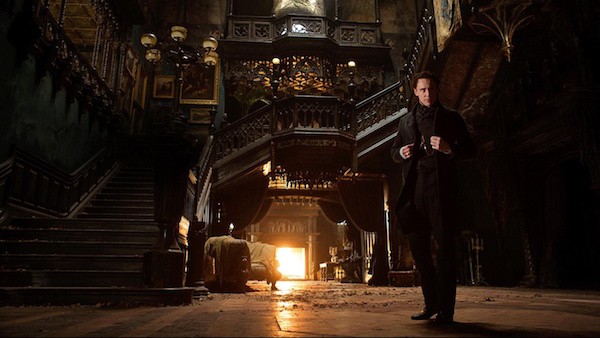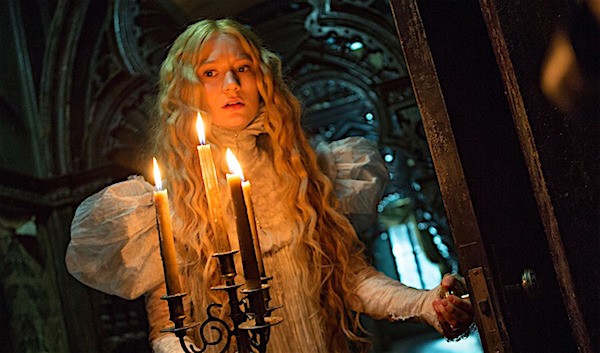
“What is a ghost?”, asks the first line of The Devil’s Backbone. “A tragedy condemned to repeat itself time and again? An emotion suspended in time. Like a blurred photograph. Like an insect trapped in amber.” This is the central conceit of Guillermo del Toro’s first ghost story, and it also happens to be the central conceit of his latest. Wrap that conceit up in layers of Austen, Brontë, Poe, and Shelley, and you’ve got Crimson Peak — a sumptuously decorated but frustrating film.
The first act is long, heavy on exposition, and moves forward in fits and starts. It must establish that Edith Cushing (Mia Wasikowska) receives a spectral warning as a young girl. Then, we jump forward fourteen years to see Edith in adulthood. Her longtime friend Alan (Charlie Hunnam) seems to be putting the moves on her. But before long, Thomas Sharpe (Tom Hiddleston) enters Edith’s life when he asks her father to finance his clay mining operation. Though Thomas is charming and handsome, his sister Lucille (Jessica Chastain) seems quite the opposite. Edith quickly falls for Thomas, and before long, Edith and the Sharpe siblings are living in Allerdale Hall, the Sharpes’ remote and decrepit mansion. Naturally, the place is positively lousy with ghosts.
Allerdale Hall is one of the best haunted houses in the past fifteen years of cinema, and I believe it has the potential to be remembered as one of the best for years to come. It is a place only villains could live. Huge, cold, drafty, and sinking into the blood-red clay pit below. It’s a practical set so ornate and wonderfully hideous that it almost seems foolish to have built it. But man, it fucking WORKS. It’s overdone in a way that only del Toro can pull off — which is an observation that could apply to any number of things in the film. He pulls off Allerdale Hall without a hitch. It’s the things he doesn’t pull off that I find so troubling.

The film’s dialogue is so stiff and literary, so dreadfully novel-of-manners that it detracts from nearly every dialogue scene. And this is one talky movie. Luckily there are certain actors that can take stuffy English dialogue and inject warmth while maintaining that crisp diction. Hiddleston is one of these actors, and he’s terrific in the movie. Wasikowska’s performance is quite good as well, looking and acting suitably ghastly in her puffy nightgowns and comically enormous blonde hairdo.
Crimson Peak’s other big turnoff is that it lacks economy of storytelling. With so much to chew through at the start, and with del Toro’s choice to use lots of energy-sapping dissolves and iris transitions, the film has trouble propelling itself on plot alone. At your standard cineplex, audience members get chatty and fidgety when a film isn’t moving forward quickly enough. Unfortunately, that was what the audience was like at my screening for most of Crimson Peak’s running time. This is not a movie for the normies. This is a movie for del Toro first, and his fandom second.
But even for his fandom, there is an image in the film so startlingly taken from The Devil’s Backbone that it threatens to break the magic of a crucial moment. Why is he repeating himself? Is that a bad thing? What a curious film, Crimson Peak. Too big to be dismissed as a mere oddity, but too odd to ever be big. All this intricacy, all this posturing, all the color and symbolism, and for what? What does it all add up to? Upon first viewing, I can’t be sure. But that’s only on first viewing. Just like the rest of del Toro’s work, Crimson Peak is good enough to invite many more.
Travis’ Rating: 




Out of a Possible 5 Stars